Chang Sŭngŏp
| Korean name | |
| Hangul | 장승업 |
|---|---|
| Hanja | 張承業 |
| RR | Jang Seungeop |
| MR | Chang Sŭngŏp |
| Art name | |
| Hangul | 오원 |
| Hanja | 吾園 |
| RR | Owon |
| MR | Owŏn |
| Courtesy name | |
| Hangul | 경유 |
| Hanja | 景猶 |
| RR | Gyeongyu |
| MR | Kyŏngyu |
Chang Sŭngŏp (Korean: 장승업; 1843–1897), commonly known by his art name Owŏn, was a Korean painter of the late Joseon period.[1]
He was one of the few painters to hold a position of rank in the Joseon court. His life was dramatized in the award-winning 2002 film Chi-hwa-seon directed by Im Kwon-taek.
Biography
Chang was orphaned at a young age and grew up in poverty. He stayed at the homes of a number of people, including Yi Ŭnghŏn (이응헌; 李應憲), Pyŏn Wŏn-kyu (변원규; 卞元圭), and O Kyŏngsŏk, where he was exposed to art.[1]
Together with the earlier painters Danwon and Hyewon, Chang is remembered today as one of the "Three Wons" of Joseon-period painting.
Gallery
-
 Samin munnyeondo
Samin munnyeondo -
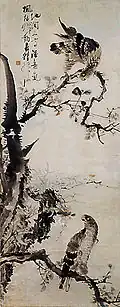 Hochwido
Hochwido -
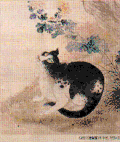 Painting of a cat by Chang
Painting of a cat by Chang -
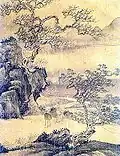 Sansu inmuldo means "the picture of a man in the landscape"
Sansu inmuldo means "the picture of a man in the landscape" -
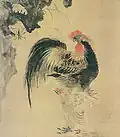 Rooster
Rooster -
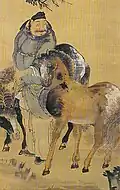 Ssangma inmuldo (the painting of a man with two horses)
Ssangma inmuldo (the painting of a man with two horses) -
 Chowon jirok
Chowon jirok
See also
Wikimedia Commons has media related to Jang Seung-eop.
References
- ^ a b 강, 영주, "장승업 (張承業)", Encyclopedia of Korean Culture (in Korean), Academy of Korean Studies, retrieved 2024-06-18